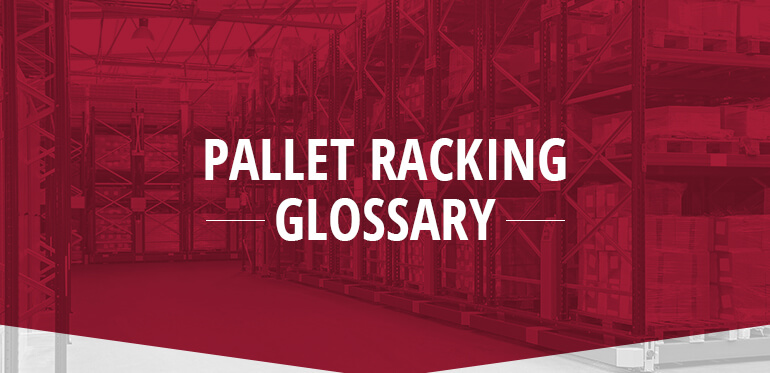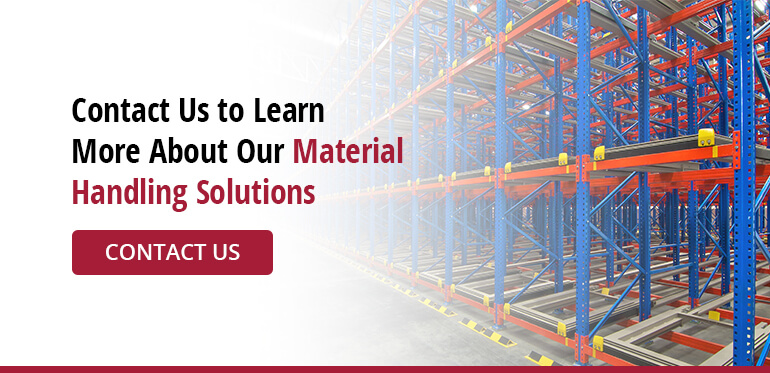
27 Jun Pallet Racking & Storage System Terms & Definitions
Are you looking to invest in a material handling or storage system for your warehouse but unsure where to start? Or perhaps you are looking to familiarize yourself with common pallet racking terminology for an upcoming project.
We have comprised a list of commonly used terms and definitions to aid in your next racking project. Continue reading our pallet racking glossary to learn more about the different storage racking types, components, and safety products found in facilities around the globe.
Aisle
An aisle is a defined space between rows of pallet racks. Aisle widths will depend on the type of racking system used and the warehouse flow outlined by design engineers. These aisles allow for pedestrian, forklift, and automated machinery traffic.
Anchor
Anchors are a type of fastener to secure racking upright columns to the concrete floor slab. Depending on the rack height, load weight, local building codes, and seismic zone of the facility, special attention is required to choosing the proper anchor bolts. There are multiple types, such as concrete, wedge, or strike anchors and lags.
Automated Storage and Retrieval System
Automated storage and retrieval systems, also known as ASRS, are fully automated material handling systems to improve storage density, throughput, and efficiency in a distribution center or warehouse. Unit-load AS/RS solutions benefit from using structural steel racking and components for added rigidity and stability.
Backstop Beam
A backstop beam helps keep pallets on the back of a rack from falling off. These back stops are usually spaced away from the racking to allow for normal product clearance. These are also referred to as pallet stops, back stops or load stops.
Base Plate
A baseplate is the footing of a racking upright anchored to the concrete slab to provide stability in a racking system. Base plate size and thickness is determined by engineers when analyzing load requirements and the seismic zone of a warehouse.
Bay
A bay is defined as the storage space between two vertical uprights. Rack bays are also referred to as a section or unit. Professionals can design bays to accommodate their products’ sizes, weights or shapes. Customized bays help businesses maximize their storage space and improve efficiency.
Beam
A beam, also known as a cross member, is a structural component of a racking system. Beams are identified as the horizontal bar located at the front and back between two uprights. These cross beams distribute the load weights to the racking uprights.
Column Protectors
Column protectors, also known as post protectors, are a type of warehouse safety product comprised of steel or polymer to prevent or minimize accidental damage to racking systems caused by forklifts. Column protectors are placed on the outside (aisle side) of an upright, protecting the front and sides of a column from damage and preventing collapse.
Cross-Aisle Tie
Cross-aisle ties are used to attach two adjacent frames together at the top, extending across the aisle or bay. These additions enhance rigidity between aisles, keeping racking structures stable.
Flue Space
Flue space is the vertical flue (space) between rows of pallet racking from the floor to the ceiling. Flue space, both transverse and longitudinal, is a safety requirement to allow sprinkler systems to suppress a fire. Although there are guidelines for determining this space, flue space dimensions requirements vary by region, therefore due diligence is required to confirm local variances in code. Regardless of measurement, it is essential to keep flue spaces free from any obstruction.
Load Capacity
Load capacity outlines the maximum weight the pallet racking system can hold. Signage must be placed in every racking section that has differing weight capacities. Overloading a pallet rack presents safety risks for employees and increases the risk of product damage.
Pallet
A pallet is a flat structure, commonly constructed from wood or plastic, to support goods when being transported throughout the supply chain from manufacturing to retail stores. Pallet requirements are determined by the industry or country of use. For example, food and beverage products in the U.S. are commonly transported on GMA (48×40″) pallets, whereas the standard in Europe is the Euro-pallet (EUR-pallet).
Pallet Rack
A pallet rack is a racking structure designated for storage of pallet loads. Despite the many rack types, they share commonalities in terms of components. Most pallet racking systems consist of vertical uprights (columns) and horizontal beams (cross members).
Pallet Supports
Pallet supports, also known as crossbars, are steel braces placed between two adjacent horizontal beams to provide additional support underneath pallet loads and strengthen pallets between beams. Usually, warehouse handlers place two or more crossbars underneath each pallet load to provide support. These structures ensure inventory remains secure and upright, reducing the possibility of pallets falling or of pallet deficiencies.
Rack Guard Ends
Rack guards are another type of rack protection used to prevent upright damage from forklifts. End guards are similar to Column Protectors, however, they span the entire width of the upright frame and are installed at opposing ends of a rack row.
Roll Form Racking
Roll form racking is a design type for pallet racking. In this structure, light gauge steel is rolled into thinner components that snap into place to create a pallet rack. Roll form racks are lighter than structural steel racks, not holding as much weight as structural steel. This type of pallet system is ideal for warehouses with rapidly changing inventory, such as seasonal products. With easy assembly and disassembly, roll form racks increase efficiency in a workspace.
Row Spacers
Row spacers are a component designed to add stability and maintain the flue space between two pallet racks installed back-to-back. They keep a consistent horizontal distance between pallet rack rows, which assists with meeting code and safety standards. Row spacers are available in various, so businesses can find one that matches their needs.
Shims
Shims are metal plates that assist with leveling racks into plumb tolerance. In other words, shims help warehouse racks reach a precise vertical position. Shims are available in many different sizes, but it is crucial to find one that matches the size of the rack’s upright baseplate. The shim’s material should also meet the warehouse floor’s bearing capacity.
Structural Steel
Structural steel is the strongest material option for pallet racking. A structural steel pallet rack is the most durable option available because the frame columns and beams are manufactured from low-gauge steel and then bolted together during installation.
The material creates thicker columns and corners, allowing racks to hold heavier weights and withstand more collisions from material handling equipment. Its extreme strength allows it to endure harsh impacts, making it ideal for heavy loads or harsh conditions. Pallet racking professionals can use structural steel in a variety of pallet applications, no matter their designs or load capacities. Structural racking systems are widely used in food, beverage, and cold storage warehouses due to heavier requirements and their resistance to fork truck damages.
Upright Frame
Upright frames are a structural component of racking systems by carrying the vertical and horizontal loads to the ground. Uprights are comprised of two vertical columns with horizontal and diagonal bracing. The height and width of an upright frame will vary depending on the application and requirements of the racking system.
Wire Decks
Wire decks, usually made from steel bars and wires, provide additional pallet support. Wire decks rest on cross beams to aid in the prevention of inventory falling through the racking system.
Contact Us to Learn More About Our Material Handling Solutions
Twinlode Automation offers pallet racking solutions, warehouse design, permitting, engineering, and system integration. We have decades of experience, and our experts can help you find the best options for your facility. If you are interested in our products or services, please contact Twinlode Automation for more information or to receive a free consultation.



